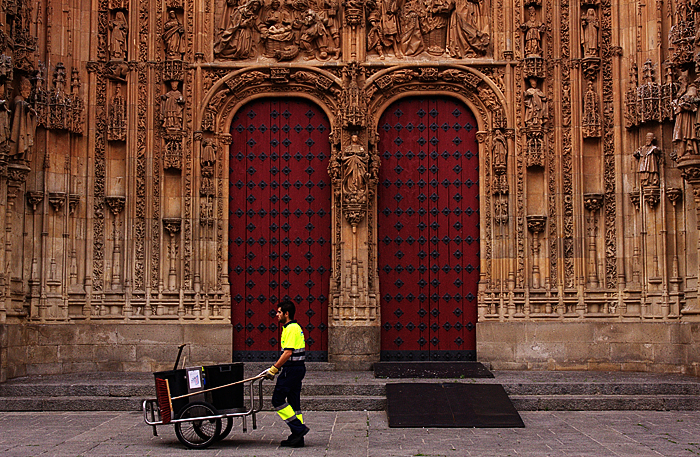by Marius Stankiewicz
While Madrid is often considered the heart of Spain—or perhaps the geographical middle of the Iberian Peninsula since you could literally stand in Puerta de Sol marking KM 0 of all outward bound roadways—Salamanca, on the other hand, may very well be the ‘golden milestone,’ the crossroads of Spanish history where the Romans, Visigoths, and Moors had all left behind a rich legacy of cuisine, language and of course, architecture.
Indulging in a few porras with thick hot chocolate, I asked a young waitress at the churrería for directions to the main square, Plaza Mayor, the place where this legacy could best be admired. She wiped her hands in a dishrag, waved me over to the front door, and pointed down the street saying “todas las calles llegan a la Plaza Mayor! All roads lead to the main square,” bringing to mind the proverb that all roads indeed lead to somewhere special, but in the case of my current trip, to Salamanca’s old quarter and not to anywhere near the Italian capital.

The premio of elegance in Salamanca is the Plaza Mayor. Built in 1755 by the Churriguera brothers, it is one of Spain’s largest squares though which unfortunately saw its last bullfight 100 years after its completion. “Nowadays,” told my guide Marina jokingly as I was taking photos of its clock tower, “the only ‘fighting’ the square sees is when the elderly discourse the fragile economy or when Erasmus students argue over a swig of bottled wine which costs no more than bottled water.”
The main square’s style is said to be Gothic-inspired and to add to the brother-architects’ horror vacui in their sculpting, all four facades possess a different number of arches though still remain to complement an unvaried and stunning loggia. When the terrace receives too much of a midday sun in the summer, ducking into one of the many cafes in the square’s periphery would be the most refreshing solution. One local favourite is Café Novelty, the oldest coffee shop in the square, which was once frequented by playwright Miguel de Unamuno.

After the siesta—which many tourists I talked with believe to be the black hole in the middle of the day—Marina and I walked down Rua Mayor and sampled some of the province’s culinary treasures at the many fancy butcher shops. Coming from the vast highland pastures near river systems, the local foods instill great pride in Salmantinos, especially one food in particular, a cheese called, Hinojosa de Duero. Of course, a chorizo (spicy pork sausage) or a salchichón (spiced salami-like sausage) would also go great with a sweet red wine bottled locally either from the Ribera del Duero or the Sierras del Salamanca. The Hornazo is also a popular dish made with flour and stuffed with pork, chorizo and hard-boiled eggs.
But a trip to this quaint city is hardly complete without trying the world-renowned, slippery, ruby reds—the Iberian Ham. Jamon Iberico de Bellota made from the pata negra pig (black hoof) was selected as the “Best ham in the world” in 2007 and 2010 by IFFA, an international tradeshow in Germany. The reason for such acclaim is that three months before slaughtering, the pigs begin a fattening regimen on sweet acorns from the Dehesa pastures, a “multifunctional agrosylvapastoral system,” which allow the pigs to feel like gluttonous royalty as there are no more than two of them fressing till satiety per hectare. Only after a pig has gained the specified weight of 160 kg (and also the priced stamp on the butcher’s invoice), can it be prepared for consumption.
The price of ham is based on the pig’s diet, exercise, and how long it hangs by its hoof in the air-dried curing process. How much for your own jamón to take home? Well, low grade Ibericos hover around 15-20 EUR per kilo but those with their final meals being acorns have a price tag anywhere from 26-38 EUR per kilo, making them not only the tastiest hams in the world but also the costliest.
- Jamon Iberico de Bellota made from the pata negra pig (black hoof) was selected as the “Best ham in the world” in 2007 and 2010
- 2000-year-old Roman Bridge
After a day of exploring, a walk back to the old quarter over the 2000-year-old Roman Bridge lead us to the Calixto and Melibea garden. It was a perfect place for Marina and I to have some of that special wine the students fight over as well as to sample some grapes from the region, what she called, ‘wine tablets.’ The garden is known for being quite verdurous and as we had a pleasant leafy ceiling over our heads, we walked through it all the way to the medieval rampart.
Marius is a writer and photographer currently living in Barcelona. You can follow him at www.mariusstankiewicz.com. Read more about Marius’ encounter with Salamanca and the Castilian lisp.
Learn more




